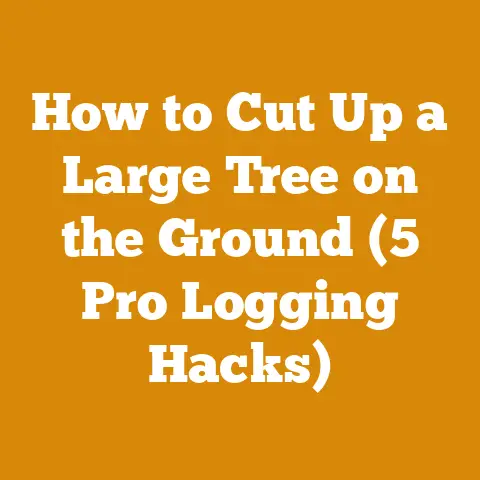Average Cost to Remove Large Tree (5 Expert Tips for Safe Logging)
In many cultures, the crackling warmth of a wood fire is more than just a heat source; it’s a connection to our ancestors, a tradition passed down through generations.
I remember my grandfather, a seasoned logger, teaching me the art of selecting the right tree, felling it with precision, and splitting the wood with respect.
He instilled in me not only the skills but also the reverence for the forest and the importance of safety above all else.
Today, I carry on that tradition, and I want to share my knowledge with you, focusing specifically on the often-challenging task of large tree removal and the costs involved.
Average Cost to Remove Large Tree (5 Expert Tips for Safe Logging)
Removing a large tree is a significant undertaking, and understanding the associated costs is crucial before you even think about firing up your chainsaw.
But cost isn’t the only factor; safety is paramount.
This guide will delve into the average costs involved in large tree removal, but more importantly, it will equip you with five expert tips to ensure safe logging practices.
Understanding the Factors Influencing the Cost of Tree Removal
The cost of removing a large tree can vary significantly depending on several factors.
It’s not as simple as a flat rate.
Tree Size and Species: This is the most obvious factor.
A towering oak will cost more to remove than a smaller maple.
Hardwoods, generally, are denser and require more effort to cut and process.
Expect to pay more for trees exceeding 60 feet in height or with a diameter greater than 36 inches.Location: Accessibility plays a huge role.
If the tree is easily accessible from the road, the cost will be lower.
If it’s in a backyard with limited access, requiring specialized equipment like cranes or climbing gear, the price will increase considerably.
Trees near power lines or structures also add to the complexity and cost.Tree Condition: A healthy tree is generally easier to remove than a diseased or dead one.
Dead trees are often brittle and unpredictable, posing a greater safety risk.
Trees with significant decay or structural weaknesses will require more careful handling and specialized techniques.Obstacles and Hazards: Proximity to buildings, power lines, fences, or other obstacles will increase the complexity and cost.
These situations often require specialized equipment and techniques to avoid damage.Stump Removal: Grinding or removing the stump adds to the overall cost.
Stump grinding is generally cheaper than complete removal, which involves digging out the entire root system.Debris Removal: The cost of removing the tree debris, including branches, trunk sections, and leaves, needs to be factored in.
Some companies include this in their initial quote, while others charge extra.Permits: Depending on your location, you may need a permit to remove a large tree, especially if it’s on public land or if it’s a protected species.
The cost of the permit will vary depending on local regulations.
Takeaway: Get multiple quotes from reputable tree service companies.
Make sure they assess all the factors above to provide an accurate estimate.
Average Cost Ranges for Large Tree Removal
While pinpoint accuracy is impossible without a site-specific assessment, I can provide general cost ranges based on my experience and industry data.
These figures are based on US dollar estimates and can vary widely depending on your geographic location.
- Small Tree (under 30 feet): \$150 – \$500
- Medium Tree (30-60 feet): \$500 – \$1,500
- Large Tree (over 60 feet): \$1,500 – \$5,000+
Keep in mind that these are just averages.
Extremely large or complex tree removals can easily exceed \$5,000.
I’ve seen removals in densely populated urban areas with difficult access cost upwards of \$10,000.
Example: I once worked on a project removing a massive, dying oak tree that was leaning precariously over a house.
The tree was over 80 feet tall, located in a tight backyard, and required a crane to safely dismantle.
The final cost, including stump grinding and debris removal, was close to \$8,000.
Takeaway: Don’t be afraid to negotiate.
Get multiple quotes and compare the services offered and the level of detail in the estimates.
Expert Tip #1: Prioritize Safety Above All Else
I cannot stress this enough: safety is the most important aspect of tree removal.
Never attempt to remove a large tree yourself unless you have the proper training, experience, and equipment.
Even then, proceed with extreme caution.
- Personal Protective Equipment (PPE): Always wear appropriate PPE, including a hard hat, safety glasses, hearing protection, gloves, chainsaw chaps, and sturdy boots.
- Hazard Assessment: Before you even start your chainsaw, carefully assess the area for potential hazards.
Look for power lines, underground utilities, obstacles, and unstable ground. - Communication: Establish clear communication with anyone assisting you.
Use hand signals or radios to ensure everyone is on the same page. - Never Work Alone: Always have someone else present to assist you and to call for help in case of an emergency.
- First Aid: Have a well-stocked first aid kit readily available and know how to use it.
Specific Tools for Safety:
- Hard Hat with Face Shield: Protects your head and face from falling debris.
- Chainsaw Chaps: Designed to stop a chainsaw blade from cutting your leg.
- Steel-Toed Boots: Provide ankle support and protect your feet from injury.
- High-Visibility Clothing: Increases your visibility to others in the work area.
Takeaway: Safety is not an option; it’s a necessity.
Invest in the proper equipment and training to protect yourself and others.
- Assess the Lean: Determine the natural lean of the tree.
This will influence the direction it will fall. - Identify the Escape Route: Clear a path away from the tree at a 45-degree angle from the anticipated direction of fall.
- Plan the Notch and Back Cut: The notch determines the direction of fall, while the back cut severs the remaining wood fibers.
- Use Wedges: Wedges can be used to help direct the fall of the tree and prevent the saw from binding.
- Consider the Weather: Wind conditions can significantly affect the fall of the tree.
Avoid felling trees in high winds.
Felling Techniques:
- Conventional Notch: A 45-degree notch cut into the tree on the side you want it to fall.
- Humboldt Notch: Similar to a conventional notch but with a slightly different angle.
- Open Face Notch: A wider notch that allows for more precise control of the fall.
Example: I once witnessed a logger who didn’t properly assess the lean of a tree.
He made his cuts according to his plan, but the tree fell in the opposite direction, narrowly missing a power line.
A proper assessment could have prevented this dangerous situation.
Takeaway: Take the time to develop a detailed felling plan before you start cutting.
This will significantly reduce the risk of accidents.
Expert Tip #3: Master Essential Chainsaw Techniques
Proper chainsaw technique is essential for both safety and efficiency.
Learn the basics and practice regularly.
- Proper Stance: Maintain a balanced stance with your feet shoulder-width apart.
- Firm Grip: Hold the chainsaw firmly with both hands.
- Avoid Kickback: Be aware of the kickback zone on the tip of the bar.
- Use the Correct Chain: Choose the right chain for the type of wood you are cutting.
- Keep the Chain Sharp: A sharp chain cuts faster and is safer to use.
Chainsaw Maintenance:
- Sharpen the Chain Regularly: Use a file or a chain grinder to keep the chain sharp.
- Clean the Air Filter: A dirty air filter can reduce engine performance.
- Check the Chain Tension: A loose chain can come off the bar.
- Lubricate the Chain: Use chainsaw bar oil to keep the chain lubricated.
Chainsaw Selection:
- Engine Size: Choose a chainsaw with the appropriate engine size for the size of the trees you will be cutting.
- Bar Length: Select a bar length that is long enough to cut through the largest trees you will be felling.
- Weight: Consider the weight of the chainsaw, especially if you will be using it for extended periods.
Takeaway: Invest in a quality chainsaw and learn how to use it properly.
Regular maintenance is key to ensuring safe and efficient operation.
Expert Tip #4: Utilize Proper Limbing and Bucking Techniques
Once the tree is on the ground, you’ll need to limb it and buck it into manageable sections.
- Limbing: Remove the branches from the trunk.
Work from the base of the tree towards the top.
Be aware of spring poles, which are branches that are under tension. - Bucking: Cut the trunk into shorter lengths.
Consider the size of your firewood stove or fireplace when determining the length of the sections. - Avoid Pinching: Use wedges or a second cut to prevent the saw from pinching.
- Support the Log: Support the log to prevent it from rolling or shifting while you are cutting.
Bucking Techniques:
- Cutting from the Top: Cut down through the log.
- Cutting from the Bottom: Cut up through the log.
- Combination Cut: Start by cutting a small notch on the top of the log and then finish the cut from the bottom.
Example: I once saw someone bucking a log without properly supporting it.
As he made the final cut, the log rolled, trapping his leg underneath.
Fortunately, he wasn’t seriously injured, but it could have been much worse.
Takeaway: Limbing and bucking can be just as dangerous as felling a tree.
Use proper techniques and take your time.
Expert Tip #5: Understand Stump Removal Options and Costs
After the tree is removed, you’ll need to decide what to do with the stump.
There are several options, each with its own cost implications.
Stump Grinding: This involves using a specialized machine to grind the stump down below ground level.
It’s generally the most cost-effective option.
Expect to pay \$2-5 per inch of stump diameter.Complete Stump Removal: This involves digging out the entire stump and root system.
It’s more expensive than stump grinding but leaves the area completely clear.
Costs can range from \$100 to \$500 or more, depending on the size of the stump and the accessibility of the area.Chemical Removal: This involves using chemicals to accelerate the decomposition of the stump.
It’s a slow process and may not be suitable for all situations.Leaving the Stump: You can simply leave the stump in place.
It will eventually decompose naturally, but this can take many years.
Stump Grinding Considerations:
- Machine Size: Choose a stump grinder that is appropriate for the size of the stump.
- Depth: Determine how deep you want to grind the stump.
- Debris Removal: Consider the cost of removing the grindings.
Takeaway: Choose the stump removal option that best suits your needs and budget.
Stump grinding is often the most practical and cost-effective solution.
Additional Cost Considerations: Insurance and Permits
Beyond the direct costs of tree removal, there are other expenses to consider.
- Insurance: Make sure the tree service company you hire has adequate insurance coverage.
This will protect you in case of accidents or damage.
Ask for proof of insurance before hiring anyone. - Permits: Check with your local municipality to see if you need a permit to remove the tree.
Permits are often required for trees that are located on public property or that are protected species.
The cost of a permit can vary depending on your location.
Checking for Insurance:
- Ask for a Certificate of Insurance: This document will verify that the company has insurance coverage.
- Contact the Insurance Company: Call the insurance company listed on the certificate to verify that the policy is current.
Permit Requirements:
- Contact Your Local Municipality: Check with your city or county government to determine if a permit is required.
- Provide Tree Information: Be prepared to provide information about the tree, such as its size, species, and location.
Takeaway: Don’t overlook insurance and permit requirements.
These can add to the overall cost of tree removal.
Finding a Reputable Tree Service Company
Choosing the right tree service company is crucial for a safe and successful tree removal.
- Get Multiple Quotes: Get quotes from at least three different companies.
- Check References: Ask for references and contact them to see what their experience was like.
- Verify Insurance and Licensing: Make sure the company is properly insured and licensed.
- Read Reviews: Check online reviews to see what other customers have said about the company.
- Ask Questions: Don’t be afraid to ask questions about their experience, equipment, and safety procedures.
Questions to Ask:
- How long have you been in business?
- Are you insured and licensed?
- What equipment do you use?
- What safety procedures do you follow?
- Do you have references?
Takeaway: Take the time to research and choose a reputable tree service company.
This will ensure a safe and professional tree removal.
Removing a large tree is a complex and potentially dangerous task.
By understanding the factors that influence the cost and following these five expert tips for safe logging, you can make informed decisions and ensure a successful outcome.
Remember, safety should always be your top priority.
If you are not comfortable performing the work yourself, hire a qualified professional.
The peace of mind is worth the investment.






